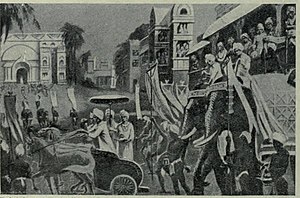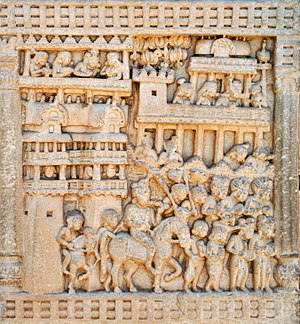Prasenajit
Prasenajit (P. Pasenadi; T. gsal rgyal གསལ་རྒྱལ་; C. bosini wang 波斯匿王) (c. 6th century BCE). King of the country of Kośala, he reigned in the city of Śrāvastī at the time of the Buddha.[1][2] His father was king Arāḍa Brahmadatta.[2]
Prasenajit became a prominent lay disciple (upāsaka) of the Buddha. As king, he gave all servants in his lands permission to join the Buddhist order if they wished.[2] He also built many monasteries for the Buddhist community. [1]
Life
Prasenajit was born at the same time as Gautama Buddha, and when his father, King Arāḍa Brahmadatta of Kosala, saw the auspicious signs of the Buddha's birth, he mistakenly believed that these signs were due to the birth of his own son.[3]
The Chapter on Going Forth (Pravrajyāvastu) states:
- King Arāḍa Brahmadatta thought, “When my son was born, the world was lit as if by the light of lights, so I shall name this prince Prasenajit (Supreme Light).” And so the boy was named Prasenajit.[3]
In his early years, Prasenajit studied in Taxila, the capital of Gandhāra. He later became king of Kosala. His first queen was a Magadhan princess, a sister of king Bimbisara.
His second queen was Vāsavakhattiyā, the daughter of Mahānāma, a Sakyan nobleman, and a slave girl. From this marriage, he had a son, Virudhaka and a daughter, Princess Vajira, who was later married to Bimbisara's son Ajātaśatru.[4][5]
He married his sister Kosala Devi to Bimbisara.[6]
Once, while Prasenajit was away from his capital Shravasti, his minister Dīgha Chārāyana placed his son Virudhaka on the throne. Upon leaning that his son had usurped his throne, Prasenajit went to Magadha to seek help from Ajātaśatru in order to regain his throne. But before being able to meet Ajātaśatru, Prasenajit died of exposure outside the gates of Rajagriha.[7]
He was succeeded by his son Virudhaka.[8]
Notes
- ↑ 1.0 1.1 Buswell & Lopez 2014, s.v. Prasenajit.
- ↑ 2.0 2.1 2.2
 གསལ་རྒྱལ་, Christian-Steinert Dictionary
གསལ་རྒྱལ་, Christian-Steinert Dictionary
- ↑ 3.0 3.1
 The Chapter on Going Forth, sect 1.11
The Chapter on Going Forth, sect 1.11
- ↑ Pasenadi. PaliKanon.com
- ↑ Sastri 1988, p. 17.
- ↑ Upinder Singh 2016, p. 271.
- ↑ Raychaudhuri H. (1972). Political History of Ancient India, Calcutta: University of Calcutta, pp.176-8,186
- ↑ Sen 1999, p. 107.
Sources
 Buswell, Robert E.; Lopez, Donald S. (2014), The Princeton Dictionary of Buddhism, Princeton University
Buswell, Robert E.; Lopez, Donald S. (2014), The Princeton Dictionary of Buddhism, Princeton University- Sastri, K. A. Nilakanta, ed. (1988) [1967], Age of the Nandas and Mauryas (Second ed.), Delhi: Motilal Banarsidass, ISBN 81-208-0465-1
- Sen, Sailendra Nath (1999) [1988], Ancient Indian History and Civilization (Second ed.), New Age International Publishers, ISBN 81-224-1198-3
- Singh, Upinder (2016), A History of Ancient and Early Medieval India: From the Stone Age to the 12th Century, Pearson, ISBN 978-81-317-1677-9
| This article includes content from Pasenadi on Wikipedia (view authors). License under CC BY-SA 3.0. |

